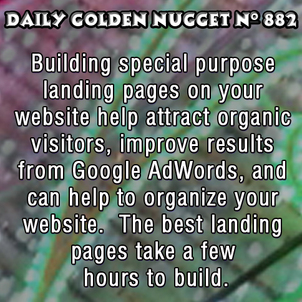 In September 2013, shortly after Google announced their new Hummingbird algorithm, I decided to set up a special website test to see exactly how organic traffic and paid traffic would differ on a unique landing page.
In September 2013, shortly after Google announced their new Hummingbird algorithm, I decided to set up a special website test to see exactly how organic traffic and paid traffic would differ on a unique landing page.On one of the website I manage I set up a landing page with 1469 words of content, 16 photos, and 37 links to other pages on the website. Indeed, this was a very complicated page that fully explained the business, all the services they provide, and the products they sold.
The copy on the page went into great detail about each area of expertise and then links to other blog posts, employee bios, and products in their product catalog. I seem to remember it took about 16 hours to completely craft this special landing page.
I initially designed the page to tie into a generic Google AdWords campaign I also designed. Normally I would design Google AdWords ads to have specific targeting for specific keywords and link to special landing pages that are designed for that single keyword. But in this special case, I had a broad set of random keywords that were all related to the store which were simply too generic for individual landing pages. So I took them all and created a full business description that included all of them.
This landing page performed well for the associated AdWords campaign group. The average Bounce Rate for the website I was testing is about 59%, which is actually pretty bad, but the bounce rate for the paid traffic to this landing page was 54% for desktop users and 62% for mobile users. It's important to note that this landing page was not mobile optimized.
I spent some time reviewing the visitor flow of this page and noticed something interesting... Almost 6% of the paid traffic clicked one of those 37 links to read a second page on the site, but then they returned back to the landing page again. This is very unusual behavior for me to identify among website visitors. I'm sure it happens every day, but certainly not to such a large degree.
In fact, this relates to the principles of the paradox of choice. The idea is that too many options create the inability to make a choice on any one thing. When it comes to a website, individual pages with too much information on it are overwhelming for readers. Some readers feel the need to systematically read everything and click all links on that page. I believe I accidentally stumbled upon an interesting psychological test here.
Turning now to the organic search results, I found that this landing page attracted 61% less traffic than each of the targeted blog posts that were written on single topics. But those who did find the page organically spent a lot of time reading it, and clicking on more pages.
In the interest of keeping this Daily Golden Nugget short I'm cutting out some additional talking points. Here are my general conclusions from this 3 month test:
1. You can use a landing page as a gateway to other pages on your website. It's best to create one gateway page per topic and link to more detailed pages on that topic.
2. Make sure to include your jewelry store lexicon on your landing pages as well as layman explanations of that lexicon.
3. Landing pages should be as long as they need to be to get your point across and fully explain your topic. Make sure you include images, photos, maybe even a video.
4. If you create an unfocused landing page like I did you will probably experience the same low organic traffic I measured. My previous work with single topic landing pages always produced better results than this one.
5. Specific landing pages for your AdWords campaigns are a necessity, and broad scope landing pages serve as targets for keywords you'd like to target, but don't want to spend a lot of time working on.
6. You should not target keywords in your SEO campaigns any more, but in this case you should make sure that the keywords in your AdWords campaign appear on this landing page at least once.








